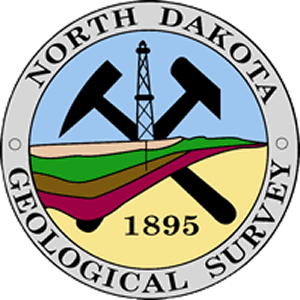
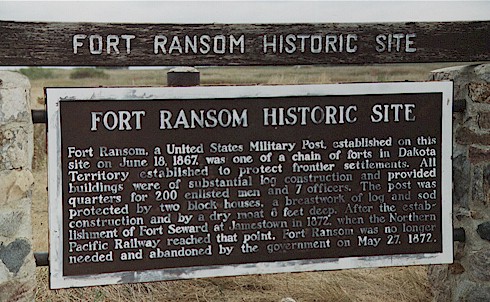 "Bottomless Pits"First, awhile back, a person from Hope, North Dakota sent me an article from the July 30, 1896 issue of the Hope Pioneer newspaper. The article describes "that famous Mud Springs, in the Sheyenne bottom." The mud spring is "about 15 miles south of Hope, across on the other side of the river" (as nearly as I can tell, that would probably place it beneath Lake Ashtabula today). The writer says the spring "has been sounded fifty feet down, and no bottom found." He went on to say: "During the summer months it is full of nice clean ice below the mud, which is about four feet deep and very sticky with pure but salty water below the mud." In this case, the Hope Pioneer writer doesn't offer an explanation for the Mud Springs. He just describes them. Over the years I've heard of a number of very deep or "bottomless" pits in various places, mainly in eastern North Dakota. Most of them are located at places where a well was drilled to the Dakota Formation, which is an artesian (pressurized) aquifer that underlies most of North Dakota ("artesian" is a word derived from the French "Artois," a region in northern France where flowing wells were once common). Large numbers of wells were drilled to the Dakota in much of eastern North Dakota in the late 1800's in search of a water supply. Many of these wells flowed salty water to the surface and in some of them the water was initially under considerable pressure. In some cases it was impossible to control the wells after they were drilled and they continued to flow indefinitely. Some of them are still flowing, although at much slower rates than when they were drilled. Because there was a continual upward flow of water from these wells, they gradually broadened into deep pools at the surface (deep, but not really "bottomless"). There are also a number of natural seeps in eastern North Dakota where slightly salty groundwater is escaping to the surface. Kelly Slough, just east of Grand Forks, is an example. Lake Ardoch, between the towns of Ardoch and Warsaw, is another. Burial MoundsIn another article dated August 13, 1896 from the Hope Pioneer, the writer commented on a picnic held at a place known as Sander's Grove or "the mounds," southeast of Cooperstown. Part of that article reads as follows: "Now just a word about those mounds. Much has been said about their construction; how they came there, and what they are; and many of us differ in our opinion, but the writer believes that they were built there by man, or men, long, long, ago." 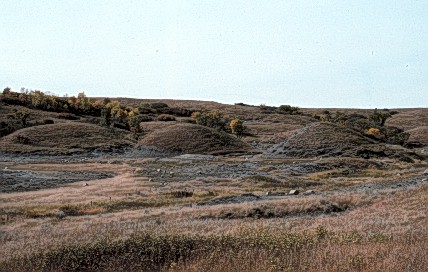 The mounds southeast of Cooperstown.
Another place where a human, man-made origin has been attributed to a naturally eroded feature is at Fort Ransom. There, a pyramid-shaped hill has been promoted over the years as a man-made feature. It's not. Rather, it is just a hill that kind of looks somewhat like a pyramid if you view it from the proper angle. I was there a couple of years ago and climbed to the top of the hill to look at the metal statue of a Viking on top. Ancient "Runestones"Also at Fort Ransom, close to the site of the old fort, are several large glacial erratics. Some of the erratics have markings on them that have been interpreted to be a kind of ancient runic writing of Scandinavian origin. The markings, at least the ones I've seen on these boulders, are not man-made. Rather, they are cupped-out depressions formed when rocks being carried by the glacier were rubbed across the surface of rocks underlying the flowing ice. Similar "striations" are often found on glacial erratics, especially limestone boulders. I've seen rune and Ogham stones in Sweden, Ireland, and Scotland and I know that similar stones have often been reported from North America. 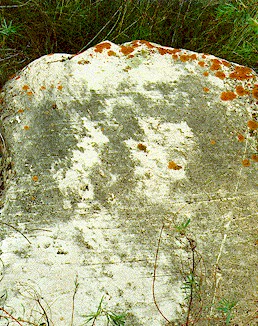 Striated limestone boulder at Fort Ransom. 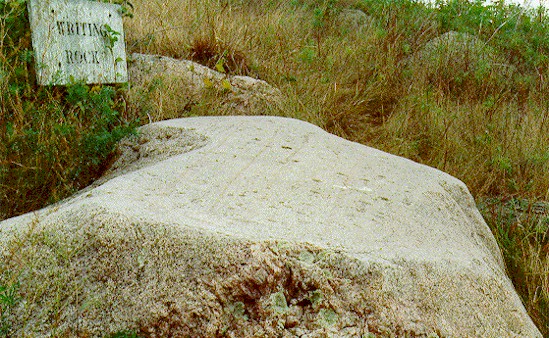 Writing Rock - Glacial striae and chattermarks on a boulder in the Fort Ransom area. 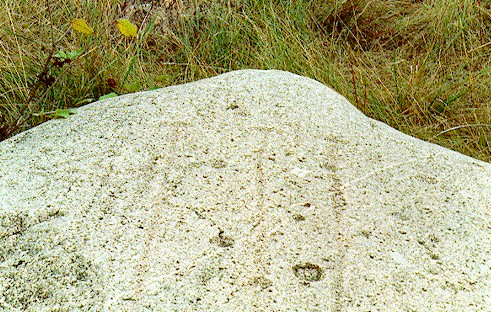 Striae on boulders at Fort Ransom. Mooring StonesI’ve also seen some large boulders in the Fort Ransom area many years ago that had cylindrical shaped holes drilled in them. Some people have suggested that these are "mooring stones," shaped by the Vikings when they sailed their ships up the Sheyenne River. Some of the legends I've heard from people in the Fort Ransom area claim that Vikings sailed their ships up the Red River of the North (or even up Lake Agassiz) and thence up the Sheyenne River (if they sailed up Lake Agassiz, it had to be no more recently tha06-Aug-2007 the lake flooded eastern North Dakota. I find that especially hard to believe). I’ve also seen similar "mooring stones" in the Turtle Mountains, at fairly high elevations. Again, Viking ships, this time navigating glacial Lake Souris, supposedly sailed into the Turtle Mountains. This idea is even more far-fetched than the Lake Agassiz sailors because, to get a ship into the Turtle Mountains would require a lake flooding much of North Dakota. My own assumption has always been that the holes were drilled in the rocks to accept an explosive charge. The rocks were blasted into smaller pieces, either to make it possible to move them off the fields or to make it possible to use the pieces for building homes or other structures. I remember my grandfather telling me that identical holes, which he showed me, were chiseled into boulders for that reason – this on his farm in northeast Iowa where I grew up. Just one more non-geological observation: I think it's interesting that, in most cases, these so-called man-made features are promoted as something done by Vikings or some other race of people of European origin. Once it was decided that the feature was man-made, then it was also obvious (to white European settlers and their descendants anyway) that mere Native Americans couldn't have done the job; it had to be white men. I'm not sure what that says about our [mainly white, European-male-oriented] thought processes. Maybe nothing. Maybe that they never heard about Cahokia near St. Louis or any of the various Maya engineering feats. Or maybe just that the Native Americans in North Dakota had more important things to do. Many other natural features in North Dakota are misunderstood and this article could go on indefinitely, but it’s definitely time to end this essay. But ask me sometime about the castle, built by dinosaurs 70 million years ago, and now eroding out of the ground near Freda, North Dakota! |